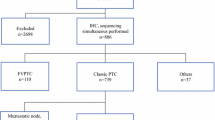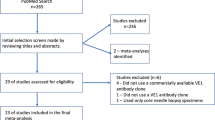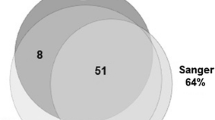Abstract
The BRAF V600E mutation is a valuable prognostic factor in thyroid carcinoma despite lingering debate. Successful immunohistochemical (IHC) detection of the BRAF V600E mutation using a VE1 antibody was introduced recently. The objective of this study was to verify the usefulness of IHC detection of the BRAF V600E mutation in thyroid carcinoma using the VE1 antibody. IHC detection of BRAF V600E was performed on various thyroid carcinoma subtypes. IHC results were compared with those obtained from real-time polymerase chain reaction (PCR) detection. Discordant cases were re-examined using a direct sequencing method following nested PCR amplification. The BRAF V600E mutation was detected in 68 % (71/104) of papillary carcinoma cases and 78 % (7/9) of anaplastic carcinoma cases. The mutation was not detected in patients with follicular carcinoma (0/18) or in medullary carcinoma (0/21). The overall sensitivity and specificity of IHC using the VE1 antibody were 100 and 94 %, respectively, suggesting that molecular-based results were indeterminable in four VE1-positive cases. IHC using the VE1 antibody is a highly sensitive and specific method for BRAF V600E mutation detection and may represent a future replacement for DNA-based molecular tests.



Similar content being viewed by others
References
Siegel R, Ma J, Zou Z, Jemal A (2014) Cancer statistics, 2014. CA Cancer J Clin 64(1):9–29. doi:10.3322/caac.21208
DeLellis RA (2006) Pathology and genetics of thyroid carcinoma. J Surg Oncol 94(8):662–669. doi:10.1002/jso.20700
Cooper DS, Doherty GM, Haugen BR, Kloos RT, Lee SL, Mandel SJ, Mazzaferri EL, McIver B, Pacini F, Schlumberger M, Sherman SI, Steward DL, Tuttle RM (2009) Revised American Thyroid Association management guidelines for patients with thyroid nodules and differentiated thyroid cancer. Thyroid 19(11):1167–1214. doi:10.1089/thy.2009.0110
Sipos JA, Mazzaferri EL (2010) Thyroid cancer epidemiology and prognostic variables. Clin Oncol (R Coll Radiol) 22(6):395–404. doi:10.1016/j.clon.2010.05.004
Tang KT, Lee CH (2010) BRAF mutation in papillary thyroid carcinoma: pathogenic role and clinical implications. J Chin Med Assoc 73(3):113–128. doi:10.1016/s1726-4901(10)70025-3
Wan PT, Garnett MJ, Roe SM, Lee S, Niculescu-Duvaz D, Good VM, Jones CM, Marshall CJ, Springer CJ, Barford D, Marais R (2004) Mechanism of activation of the RAF-ERK signaling pathway by oncogenic mutations of B-RAF. Cell 116(6):855–867
Davies H, Bignell GR, Cox C, Stephens P, Edkins S, Clegg S, Teague J, Woffendin H, Garnett MJ, Bottomley W, Davis N, Dicks E, Ewing R, Floyd Y, Gray K, Hall S, Hawes R, Hughes J, Kosmidou V, Menzies A, Mould C, Parker A, Stevens C, Watt S, Hooper S, Wilson R, Jayatilake H, Gusterson BA, Cooper C, Shipley J, Hargrave D, Pritchard-Jones K, Maitland N, Chenevix-Trench G, Riggins GJ, Bigner DD, Palmieri G, Cossu A, Flanagan A, Nicholson A, Ho JW, Leung SY, Yuen ST, Weber BL, Seigler HF, Darrow TL, Paterson H, Marais R, Marshall CJ, Wooster R, Stratton MR, Futreal PA (2002) Mutations of the BRAF gene in human cancer. Nature 417(6892):949–954. doi:10.1038/nature00766
Lanzilotta SG, Grammatica L, Paradiso A, Simone G (2007) BRAF in papillary thyroid carcinoma. Cell Oncol 29(4):269–277
Fugazzola L, Puxeddu E, Avenia N, Romei C, Cirello V, Cavaliere A, Faviana P, Mannavola D, Moretti S, Rossi S, Sculli M, Bottici V, Beck-Peccoz P, Pacini F, Pinchera A, Santeusanio F, Elisei R (2006) Correlation between B-RAFV600E mutation and clinico-pathologic parameters in papillary thyroid carcinoma: data from a multicentric Italian study and review of the literature. Endocr Relat Cancer 13(2):455–464. doi:10.1677/erc.1.01086
Ito Y, Yoshida H, Maruo R, Morita S, Takano T, Hirokawa M, Yabuta T, Fukushima M, Inoue H, Tomoda C, Kihara M, Uruno T, Higashiyama T, Takamura Y, Miya A, Kobayashi K, Matsuzuka F, Miyauchi A (2009) BRAF mutation in papillary thyroid carcinoma in a Japanese population: its lack of correlation with high-risk clinicopathological features and disease-free survival of patients. Endocr J 56(1):89–97
Koperek O, Kornauth C, Capper D, Berghoff AS, Asari R, Niederle B, von Deimling A, Birner P, Preusser M (2012) Immunohistochemical detection of the BRAF V600E-mutated protein in papillary thyroid carcinoma. Am J Surg Pathol 36(6):844–850. doi:10.1097/PAS.0b013e318246b527
Xing M (2007) BRAF mutation in papillary thyroid cancer: pathogenic role, molecular bases, and clinical implications. Endocr Rev 28(7):742–762. doi:10.1210/er.2007-0007
Elisei R, Ugolini C, Viola D, Lupi C, Biagini A, Giannini R, Romei C, Miccoli P, Pinchera A, Basolo F (2008) BRAF(V600E) mutation and outcome of patients with papillary thyroid carcinoma: a 15-year median follow-up study. J Clin Endocrinol Metab 93(10):3943–3949. doi:10.1210/jc.2008-0607
Basolo F, Torregrossa L, Giannini R, Miccoli M, Lupi C, Sensi E, Berti P, Elisei R, Vitti P, Baggiani A, Miccoli P (2010) Correlation between the BRAF V600E mutation and tumor invasiveness in papillary thyroid carcinomas smaller than 20 millimeters: analysis of 1060 cases. J Clin Endocrinol Metab 95(9):4197–4205. doi:10.1210/jc.2010-0337
Kim KH, Kang DW, Kim SH, Seong IO, Kang DY (2004) Mutations of the BRAF gene in papillary thyroid carcinoma in a Korean population. Yonsei Med J 45(5):818–821
Jeong D, Jeong Y, Park JH, Han SW, Kim SY, Kim YJ, Kim SJ, Hwangbo Y, Park S, Cho HD, Oh MH, Yang SH, Kim CJ (2013) BRAF (V600E) mutation analysis in papillary thyroid carcinomas by peptide nucleic acid clamp real-time PCR. Ann Surg Oncol 20(3):759–766. doi:10.1245/s10434-012-2494-0
Rossi ED, Martini M, Capodimonti S, Lombardi CP, Pontecorvi A, Vellone VG, Zannoni GF, Larocca LM, Fadda G (2013) BRAF (V600E) mutation analysis on liquid-based cytology-processed aspiration biopsies predicts bilaterality and lymph node involvement in papillary thyroid microcarcinoma. Cancer Cytopathol 121(6):291–297. doi:10.1002/cncy.21258
Elisei R, Viola D, Torregrossa L, Giannini R, Romei C, Ugolini C, Molinaro E, Agate L, Biagini A, Lupi C, Valerio L, Materazzi G, Miccoli P, Piaggi P, Pinchera A, Vitti P, Basolo F (2012) The BRAF(V600E) mutation is an independent, poor prognostic factor for the outcome of patients with low-risk intrathyroid papillary thyroid carcinoma: single-institution results from a large cohort study. J Clin Endocrinol Metab 97(12):4390–4398. doi:10.1210/jc.2012-1775
Xing M, Alzahrani AS, Carson KA, Viola D, Elisei R, Bendlova B, Yip L, Mian C, Vianello F, Tuttle RM, Robenshtok E, Fagin JA, Puxeddu E, Fugazzola L, Czarniecka A, Jarzab B, O’Neill CJ, Sywak MS, Lam AK, Riesco-Eizaguirre G, Santisteban P, Nakayama H, Tufano RP, Pai SI, Zeiger MA, Westra WH, Clark DP, Clifton-Bligh R, Sidransky D, Ladenson PW, Sykorova V (2013) Association between BRAF V600E mutation and mortality in patients with papillary thyroid cancer. JAMA 309(14):1493–1501. doi:10.1001/jama.2013.3190
Barollo S, Pennelli G, Vianello F, Watutantrige Fernando S, Negro I, Merante Boschin I, Pelizzo MR, Rugge M, Mantero F, Nacamulli D, Girelli ME, Busnardo B, Mian C (2010) BRAF in primary and recurrent papillary thyroid cancers: the relationship with (131)I and 2-[(18)F]fluoro-2-deoxy-D-glucose uptake ability. Eur J Endocrinol 163(4):659–663. doi:10.1530/eje-10-0290
Dvorak K, Aggeler B, Palting J, McKelvie P, Ruszkiewicz A, Waring P (2014) Immunohistochemistry with the anti-BRAF V600E (VE1) antibody: impact of pre-analytical conditions and concordance with DNA sequencing in colorectal and papillary thyroid carcinoma. Pathology 46(6):509–517. doi:10.1097/pat.0000000000000119
Routhier CA, Mochel MC, Lynch K, Dias-Santagata D, Louis DN, Hoang MP (2013) Comparison of 2 monoclonal antibodies for immunohistochemical detection of BRAF V600E mutation in malignant melanoma, pulmonary carcinoma, gastrointestinal carcinoma, thyroid carcinoma, and gliomas. Hum Pathol 44(11):2563–2570. doi:10.1016/j.humpath.2013.06.018
Ghossein RA, Katabi N, Fagin JA (2013) Immunohistochemical detection of mutated BRAF V600E supports the clonal origin of BRAF-induced thyroid cancers along the spectrum of disease progression. J Clin Endocrinol Metab 98(8):E1414–E1421. doi:10.1210/jc.2013-1408
Crescenzi A, Guidobaldi L, Nasrollah N, Taccogna S, Cicciarella Modica DD, Turrini L, Nigri G, Romanelli F, Valabrega S, Giovanella L, Onetti Muda A, Trimboli P (2014) Immunohistochemistry for BRAF(V600E) antibody VE1 performed in core needle biopsy samples identifies mutated papillary thyroid cancers. Horm Metab Res 46(5):370–374. doi:10.1055/s-0034-1368700
Capper D, Preusser M, Habel A, Sahm F, Ackermann U, Schindler G, Pusch S, Mechtersheimer G, Zentgraf H, von Deimling A (2011) Assessment of BRAF V600E mutation status by immunohistochemistry with a mutation-specific monoclonal antibody. Acta Neuropathol 122(1):11–19. doi:10.1007/s00401-011-0841-z
Bullock M, O’Neill C, Chou A, Clarkson A, Dodds T, Toon C, Sywak M, Sidhu SB, Delbridge LW, Robinson BG, Learoyd DL, Capper D, von Deimling A, Clifton-Bligh RJ, Gill AJ (2012) Utilization of a MAB for BRAF(V600E) detection in papillary thyroid carcinoma. Endocr Relat Cancer 19(6):779–784. doi:10.1530/erc-12-0239
Fisher KE, Neill SG, Ehsani L, Caltharp SA, Siddiqui MT, Cohen C (2014) Immunohistochemical investigation of BRAF p.V600E mutations in thyroid carcinoma using 2 separate BRAF antibodies. Appl Immunohistochem Mol Morphol 22(8):562–567. doi:10.1097/PAI.0b013e3182a2f75f
Ilie MI, Lassalle S, Long-Mira E, Bonnetaud C, Bordone O, Lespinet V, Lamy A, Sabourin JC, Haudebourg J, Butori C, Guevara N, Peyrottes I, Sadoul JL, Bozec A, Santini J, Capper D, von Deimling A, Emile JF, Hofman V, Hofman P (2014) Diagnostic value of immunohistochemistry for the detection of the BRAF(V600E) mutation in papillary thyroid carcinoma: comparative analysis with three DNA-based assays. Thyroid 24(5):858–866. doi:10.1089/thy.2013.0302
Kim YH, Choi SE, Yoon SO, Hong SW (2014) A testing algorithm for detection of the B-type Raf kinase V600E mutation in papillary thyroid carcinoma. Hum Pathol 45(7):1483–1488. doi:10.1016/j.humpath.2014.02.025
Rossi ED, Martini M, Capodimonti S, Cenci T, Straccia P, Angrisani B, Ricci C, Lanza P, Lombardi CP, Pontecorvi A, Larocca LM, Fadda G (2014) Analysis of immunocytochemical and molecular BRAF expression in thyroid carcinomas: a cytohistologic institutional experience. Cancer Cytopathol 122(7):527–535. doi:10.1002/cncy.21416
Zagzag J, Pollack A, Dultz L, Dhar S, Ogilvie JB, Heller KS, Deng FM, Patel KN (2013) Clinical utility of immunohistochemistry for the detection of the BRAF v600e mutation in papillary thyroid carcinoma. Surgery 154(6):1199–1204. doi:10.1016/j.surg.2013.06.020, discussion 1204–1195
LiVolsi VA, Albores-Saavedra J, Asa SL, Baloch ZW, Sobrinho-Simoes M, Wenig B, DeLellis RA, Cady B, Mazzaferri EL, Hay I, Fagin JA, Weber AL, Caruso P, Voutilainen PE, Franssila KO, Williams ED, Schneider AB, Nikiforov Y, Rabes HM, Akslen L, Ezzat S, Santoro M, Eng C, Harach HR (2004) Papillary carcinoma. In: DeLellis RA, Lloyd RV, Heitz PU, Eng C (eds) Pathology and genetics of tumours of endocrine organs. World Health Organization classification of tumours. IARC Press, Geneva, pp 57–66
American Joint Committee on Cancer, (2010) Thyroid. In: Edge SB, Byrd DR, Compton CC, Fritz AG, Greene FL, Trotti A (eds) AJCC cancer staging manual, vol 41, 7th edn. Springer, New York, pp 87–100
Khoo ML, Asa SL, Witterick IJ, Freeman JL (2002) Thyroid calcification and its association with thyroid carcinoma. Head Neck 24(7):651–655. doi:10.1002/hed.10115
Moskaluk CA, Kern SE (1997) Microdissection and polymerase chain reaction amplification of genomic DNA from histological tissue sections. Am J Pathol 150(5):1547–1552
Kwak JY, Han KH, Yoon JH, Kim EK, Moon HJ, Kim YL, Park SJ, Choi JR (2012) BRAFV600E mutation testing in fine needle aspirates of thyroid nodules: potential value of real-time PCR. Ann Clin Lab Sci 42(3):258–265
Pu X, Pan Z, Huang Y, Tian Y, Guo H, Wu L, He X, Chen X, Zhang S, Lin T (2013) Comparison of KRAS/BRAF mutations between primary tumors and serum in colorectal cancer: biological and clinical implications. Oncol Lett 5(1):249–254. doi:10.3892/ol.2012.963
Janssen CS, Sibbett R, Henriquez FL, McKay IC, Kemp EG, Roberts F (2008) The T1799A point mutation is present in posterior uveal melanoma. Br J Cancer 99(10):1673–1677. doi:10.1038/sj.bjc.6604731
McKelvie PA, Chan F, Yu Y, Waring P, Gresshoff I, Farrell S, Williams RA (2013) The prognostic significance of the BRAF V600E mutation in papillary thyroid carcinoma detected by mutation-specific immunohistochemistry. Pathology 45(7):637–644. doi:10.1097/pat.0000000000000008
Jung YY, Yoo JH, Park ES, Kim MK, Lee TJ, Cho BY, Chung YJ, Kang KH, Ahn HY, Kim HS (2015) Clinicopathologic correlations of the BRAF(V600E) mutation, BRAF V600E immunohistochemistry, and BRAF RNA in situ hybridization in papillary thyroid carcinoma. Pathol Res Pract 211(2):162–170. doi:10.1016/j.prp.2014.10.005
Toon CW, Walsh MD, Chou A, Capper D, Clarkson A, Sioson L, Clarke S, Mead S, Walters RJ, Clendenning M, Rosty C, Young JP, Win AK, Hopper JL, Crook A, von Deimling A, Jenkins MA, Buchanan DD, Gill AJ (2013) BRAFV600E immunohistochemistry facilitates universal screening of colorectal cancers for Lynch syndrome. Am J Surg Pathol 37(10):1592–1602. doi:10.1097/PAS.0b013e31828f233d
Kim HS, Kim JO, Lee DH, Lee HC, Kim HJ, Kim JH, Jang YS, Lee JM, Kim SY, Kim YS (2011) Factors influencing the detection of the BRAF T1799A mutation in papillary thyroid carcinoma. Oncol Rep 25(6):1639–1644. doi:10.3892/or.2011.1225
Zimmermann AK, Camenisch U, Rechsteiner MP, Bode-Lesniewska B, Rossle M (2014) Value of immunohistochemistry in the detection of BRAF(V600E) mutations in fine-needle aspiration biopsies of papillary thyroid carcinoma. Cancer Cytopathol 122(1):48–58. doi:10.1002/cncy.21352
Puxeddu E, Durante C, Avenia N, Filetti S, Russo D (2008) Clinical implications of BRAF mutation in thyroid carcinoma. Trends Endocrinol Metab 19(4):138–145. doi:10.1016/j.tem.2007.12.003
Xing M (2005) BRAF mutation in thyroid cancer. Endocr Relat Cancer 12(2):245–262. doi:10.1677/erc.1.0978
Capper D, Berghoff AS, Magerle M, Ilhan A, Wohrer A, Hackl M, Pichler J, Pusch S, Meyer J, Habel A, Petzelbauer P, Birner P, von Deimling A, Preusser M (2012) Immunohistochemical testing of BRAF V600E status in 1,120 tumor tissue samples of patients with brain metastases. Acta Neuropathol 123(2):223–233. doi:10.1007/s00401-011-0887-y
de Biase D, Cesari V, Visani M, Casadei GP, Cremonini N, Gandolfi G, Sancisi V, Ragazzi M, Pession A, Ciarrocchi A, Tallini G (2014) High-sensitivity BRAF mutation analysis: BRAF V600E is acquired early during tumor development but is heterogeneously distributed in a subset of papillary thyroid carcinomas. J Clin Endocrinol Metab 99(8):E1530–E1538. doi:10.1210/jc.2013-4389
Lassalle S, Hofman V, Ilie M, Butori C, Bozec A, Santini J, Vielh P, Hofman P (2010) Clinical impact of the detection of BRAF mutations in thyroid pathology: potential usefulness as diagnostic, prognostic and theragnostic applications. Curr Med Chem 17(17):1839–1850
Giannini R, Ugolini C, Lupi C, Proietti A, Elisei R, Salvatore G, Berti P, Materazzi G, Miccoli P, Santoro M, Basolo F (2007) The heterogeneous distribution of BRAF mutation supports the independent clonal origin of distinct tumor foci in multifocal papillary thyroid carcinoma. J Clin Endocrinol Metab 92(9):3511–3516. doi:10.1210/jc.2007-0594
Silver CE, Owen RP, Rodrigo JP, Rinaldo A, Devaney KO, Ferlito A (2011) Aggressive variants of papillary thyroid carcinoma. Head Neck 33(7):1052–1059. doi:10.1002/hed.21494
Min HS, Lee C, Jung KC (2013) Correlation of immunohistochemical markers and BRAF mutation status with histological variants of papillary thyroid carcinoma in the Korean population. J Korean Med Sci 28(4):534–541. doi:10.3346/jkms.2013.28.4.534
Chen JH, Faquin WC, Lloyd RV, Nose V (2011) Clinicopathological and molecular characterization of nine cases of columnar cell variant of papillary thyroid carcinoma. Mod Pathol 24(5):739–749. doi:10.1038/modpathol.2011.2
Sheu SY, Schwertheim S, Worm K, Grabellus F, Schmid KW (2007) Diffuse sclerosing variant of papillary thyroid carcinoma: lack of BRAF mutation but occurrence of RET/PTC rearrangements. Mod Pathol 20(7):779–787. doi:10.1038/modpathol.3800797
Nikiforova MN, Kimura ET, Gandhi M, Biddinger PW, Knauf JA, Basolo F, Zhu Z, Giannini R, Salvatore G, Fusco A, Santoro M, Fagin JA, Nikiforov YE (2003) BRAF mutations in thyroid tumors are restricted to papillary carcinomas and anaplastic or poorly differentiated carcinomas arising from papillary carcinomas. J Clin Endocrinol Metab 88(11):5399–5404. doi:10.1210/jc.2003-030838
Quiros RM, Ding HG, Gattuso P, Prinz RA, Xu X (2005) Evidence that one subset of anaplastic thyroid carcinomas are derived from papillary carcinomas due to BRAF and p53 mutations. Cancer 103(11):2261–2268. doi:10.1002/cncr.21073
Hauschild A, Grob JJ, Demidov LV, Jouary T, Gutzmer R, Millward M, Rutkowski P, Blank CU, Miller WH Jr, Kaempgen E, Martin-Algarra S, Karaszewska B, Mauch C, Chiarion-Sileni V, Martin AM, Swann S, Haney P, Mirakhur B, Guckert ME, Goodman V, Chapman PB (2012) Dabrafenib in BRAF-mutated metastatic melanoma: a multicentre, open-label, phase 3 randomised controlled trial. Lancet 380(9839):358–365. doi:10.1016/s0140-6736(12)60868-x
Chapman PB, Hauschild A, Robert C, Haanen JB, Ascierto P, Larkin J, Dummer R, Garbe C, Testori A, Maio M, Hogg D, Lorigan P, Lebbe C, Jouary T, Schadendorf D, Ribas A, O’Day SJ, Sosman JA, Kirkwood JM, Eggermont AM, Dreno B, Nolop K, Li J, Nelson B, Hou J, Lee RJ, Flaherty KT, McArthur GA (2011) Improved survival with vemurafenib in melanoma with BRAF V600E mutation. N Engl J Med 364(26):2507–2516. doi:10.1056/NEJMoa1103782
Acknowledgments
This study was supported by a grant from the National R&D Program for Cancer Control, Ministry of Health & Welfare, Republic of Korea (0720570).
Conflict of interest
We declare that we have no conflict of interest.
Author information
Authors and Affiliations
Corresponding authors
Additional information
Jong-In Na and Jo-Heon Kim contributed equally to this work.
Rights and permissions
About this article
Cite this article
Na, JI., Kim, JH., Kim, HJ. et al. VE1 immunohistochemical detection of the BRAF V600E mutation in thyroid carcinoma: a review of its usefulness and limitations. Virchows Arch 467, 155–168 (2015). https://doi.org/10.1007/s00428-015-1773-0
Received:
Revised:
Accepted:
Published:
Issue Date:
DOI: https://doi.org/10.1007/s00428-015-1773-0




